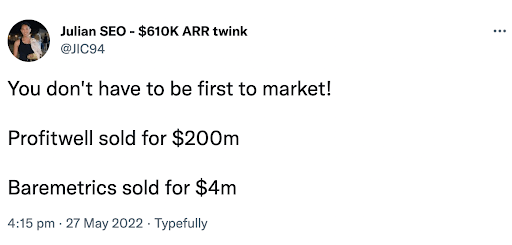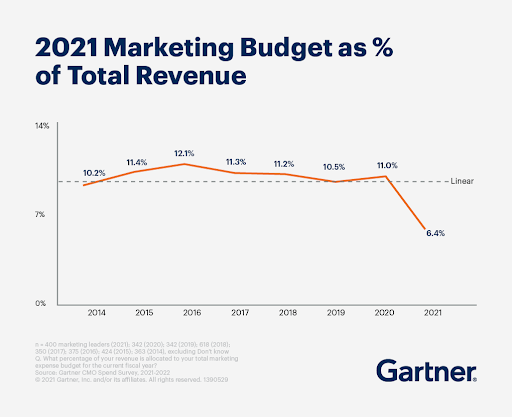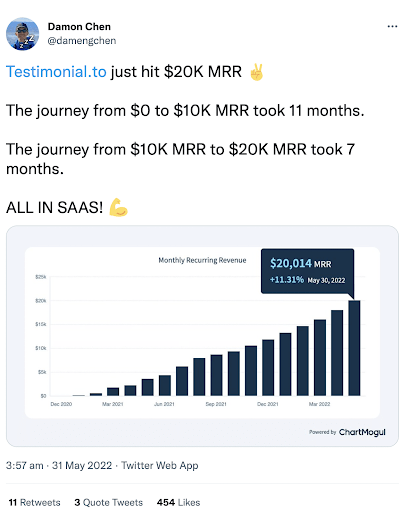SaaS Marketing Budget, How Much to Spend? Breakdown & Examples
You need a smart, growth-focused marketing strategy to propel your SaaS business to success. Unfortunately, building an effective marketing budget can be tricky and time-consuming. Many founders are uncertain about which marketing channels they should be investing in, and in turn, many SaaS businesses fail to invest enough in the right channels to fuel their growth.
At Growth Mentor, we believe that 1-on-1 sessions with growth and digital marketing mentors can be an effective way to figure out the tricky aspects of scaling your SaaS startup. Find out how world-class guidance from marketing experts can help you build a balanced, sustainable SaaS marketing budget later on!
What is a SaaS Marketing Budget?
Whilst it may seem self-explanatory, many SaaS founders aren’t too sure of which expenses should be included in their marketing budget. A marketing budget is a schedule of expenses your business plans on spending on marketing-related activities.
Such budgets are typically generated on an annual basis, but often for hyper-growth, agile SaaS businesses, this is reduced to a quarter (or even monthly).
What expenses are considered part of the marketing budget? A marketing budget will encompass the prices and fees you’ll expect to pay for the following channels & aspects of marketing:
- Social media marketing
- Online advertising (e.g. Google Ads, Facebook Ads etc.)
- Customer Relationship Management (CRM)
- SEO & Content Marketing
- Outreach and influencer marketing
- Marketing automation solutions
- Lead capture and generation
- Data collection and analytics
By expenses, we’re including every penny spent on these areas. This includes the cost of software tools, the cost and salary of hiring new employees, freelancers’ fees, paying advertising & SEO agencies etc.
Related: Learn more about SaaS reporting and its importance
Why is Formulating a SaaS Marketing Budget so important?
Developing and sticking to a SaaS marketing budget is important for a few reasons:
- It allows you to track your spending and ensure you are getting a good return on investment (ROI) for your efforts.
- It forces you to be strategic about your marketing efforts, and focus on initiatives that will have the biggest impact.
- It allows you to distribute resources appropriately, and make sure you are targeting the right prospects with the right messages.
- It helps you stay ahead of the competition, who are also likely investing in marketing.
Without a solid budget, it’s impossible to create a successful marketing strategy. A key aspect of selecting marketing projects is handling their returns on investment (ROI). Without understanding your unit economics, you risk overspending and wasting time growing channels that aren’t providing returns. Just look at the spectacular crash of Pets.com back in the early 2000s, a VC-backed startup that burned $300 million in less than 9 months by spending most of its marketing budgets on ads that didn’t work.
Conversely, many small SaaS firms could also underinvest, effectively leaving growth on the table by being too conservative with their marketing spending.
The key here is simple to grasp, yet hard to execute: invest in channels that work. While early-stage SaaS businesses might not have this advantage, those scaling growth need to analyze insights on revenue growth and double down their marketing spend on channels and tactics that have worked.
This is a standard mistake that many budget-conscious SaaS bootstrappers often make. A first-mover in the market, Baremetrics founder Josh Pigford sold the platform for $4 million, while ProfitWell, a direct competitor, was sold for a whopping $200 million, and we reckon that the staggering difference in price boils down to their different growth trajectories, despite having very similar products.
According to the staff at Moss, adopting a spend management system can help you spend smarter, but that’s not the only thing you should do. You also need to develop a method for deciding your marketing budget.
Methods for Deciding Marketing Budget
How should your B2B SaaS company decide how much overall to spend on marketing?
Here, we will evaluate some common methods for doing so:
Budget by Revenue Percentage: How do marketing budgets differ for SaaS businesses?
If you’ve read anything about marketing for so-called ‘normal businesses’, you’ve probably come across the “10% rule”. That is, businesses should spend around 7-10% of their revenue on marketing budgets.
And, indeed, this is true for many businesses across many market sectors.
According to Gartner – despite a fall in budgets in 2021 owing to poor confidence – the average CMO marketing spending for companies hovers at the 10% line.
Does this differ for SaaS companies? According to a SaaS Capital survey, SaaS firms with above-median growth spend, on average, 14% of their revenue on marketing.
However, especially in the early phases of growth, SaaS providers will spend far more than this (and may even outspend their revenue on marketing) in order to establish their brand and product in the market.
Though, this also applies to many of the big SaaS players, who often spend in excess of 40% of their revenue on marketing. Salesforce spends 46% of its revenue on marketing, Zendesk spends 48% whilst ServiceNow spends 44%.
All of the above companies have used their high marketing budgets to establish dominance in their respective product categories and see insane levels of rapid, sustainable growth.
Why is this possible? Or, more importantly, why is such a high marketing budget necessary?
- B2B SaaS firms experience high customer acquisition costs (CAC).
- The Cost of Goods Sold (COGS) is generally low for SaaS firms.
For one, the customer acquisition cost (CAC) is typically much higher for SaaS businesses. This is because they rely on a low number of customers to generate a large amount of revenue, so they’d need to invest in scalable systems to sustain growth.
In order to make up for the high CAC, SaaS businesses often spend more on marketing than other types of businesses.
Secondly, once you’ve developed your SaaS product, your unit costs plummet. While traditional businesses have Cost of Goods Sold (COGS) of 80% – having to pay for brick-and-mortar stores, wholesale goods, transport and logistics etc, SaaS businesses don’t.
Sure, there are maintenance, admin and support costs. But primarily, you have an almost unlimited inventory – so now you need to sell your product! With barriers to entry low for the SaaS industry, marketing spend is a key tool for establishing market share.
So, for SaaS companies, the budget by revenue percentage method isn’t satisfactory. SaaS firms are too agile and lean in respect to costs to benefit from such a strict limit.
Budget by MRR: Implementing the Golden Ratio (LTV-CAC)
Our second method involves optimizing two “levers” of a SaaS business, your lifetime value (LTV) and your customer acquisition cost (CAC). The ratio of which describes how much value to your organization brings on one customer affords.
This method is still revenue-based – as we’re looking at desired revenue now. But it takes into account how much value is generated by each customer.
The so-called ‘golden ratio’ states that your LTV-CAC ratio should be 3:1. That is, there should be a 3X ROI for a customer acquisition.
We can use this ratio to calculate an ideal marketing budget given a target MRR.
First, we’ll need to calculate a few key metrics:
Desired MRR
What is your goal for MRR? MRR – or Monthly Recurring Revenue – represents your stable, subscription revenue divided into monthly amounts. Most SaaS companies will know their target MRR. Payment and subscription analytics tools like Stripe, ChartMogul, and ProfitWell automatically calculate this metric.
New Customers Needed
How many new customers do you need to achieve your MRR?
For SaaS firms, this is particularly easy to determine:
Churn Rate
Churn rate is the percentage of customers who cancel their service or product over time. A high churn rate can be a sign that a company is having trouble retaining customers. It’s calculated by dividing the number of customers who cancelled their subscriptions in a given month by the total number of customers at the beginning of that month.
Using a product analytics platform, determining your average monthly churn rate shouldn’t be too difficult. We’ll need to know this for the Customer Lifetime Value (LTV) formula.
Examining LTV and CAC
Customer lifetime value (LTV or CLV) can be calculated using a variety of methods. The one we’re using here is:
Conversely, we’re calculating CAC as:
If we’re targeting an LTV/CAC ratio of 3:1, we can write this as:
To use a churn rate, we’ll also need to express MRR in per-customer (or per account) form. We’ll need to replace MRR with APRA: Average Revenue Per Account:
That gives us:
For example, consider a company that currently has a $5,000 MRR and desires a $10,000 MRR. Their churn rate is 30%, and their subscription price is $50 per month.
Firstly, how many customers are needed to generate $5,000? 5000/50 = 100. APRA is 10,000/150=200/3
With this information, the ideal marketing budget can be found:
Which SaaS marketing channels to invest in?
Of course, the total marketing budget isn’t the only factor to consider. What’s also important is what marketing channels to invest in. Why? It’s clear: different marketing channels offer differing returns on investment (ROI).
- If you don’t have a network to leverage, consider doing cold outreach and incentivising word-of-mouth growth through building a brand on social media, getting affiliates, offering loyalty-based customer discounts, and the like. Once founder Nathan Barry figured out his target market, ConvertKit transformed from a failing business to an email marketing juggernaut with more than $30 million in ARR.
- Research from marketing agency First Page Sage found that the highest ROI for a marketing channel belonged to thought leadership SEO – essentially a content SEO strategy where new ideas and interesting takes are woven into content. This returned SaaS businesses an average ROI of 748%.
- Email marketing is another lucrative marketing channel – offering an ROI of 201% according to First Page Sage. Email marketing is great once you’ve scaled traffic acquisition and now need to focus on converting them into subscribers and paying subscribers. The ROI is primarily down to the incredibly low cost of email marketing campaigns. The least effective marketing channel is PPC advertising – only returning an ROI of 46%.
It’s also important to consider the time commitments of marketing channels. For example, SEO can take months – anywhere from 4 months to 2 years! PPC online advertising is still a popular choice for some firms as results are likely to be shown within 3 months if done right.
Why is Content Marketing so Lucrative?
It is scalable and has a replicable process to sustain growth.
Lead generation with SaaS tools is particularly difficult. Why? It’s inherently hard to convey the benefits of your product. Compare this with any other business – say an eCommerce business. They could send out coupon codes or advertise deals for sunglasses on Facebook, as there’s likely to be an inherent, pre-existing understanding of the product they’re selling. However, B2B SaaS products are mostly subscription-based, hard to be upsold (unless the business model is credit-based), and are marketed based on whether they add value to businesses. That’s quite hard to do using traditional marketing channels.
That’s why B2B SaaS providers love turning to SEO content marketing. This channel involves educating its potential customer base through evergreen content on problems their product can solve. That includes blog posts, podcasts and webinars all explaining the value and problem-solving capabilities of the product.
Want to learn more about how SaaS startups can use content SEO to get their business off the ground? Check out our comprehensive guide on SaaS SEO here!
Develop your marketing budget & strategy with Growth Mentor!
Marketing budgets and strategies are ultimately unique to your business – and take time to get right.
That’s why working with a mentor is the best way to propel your SaaS product to success. Growth mentors are industry professionals ready to offer you 1-to-1 sessions and expert advice. Not sure about your marketing budget? Need some help developing your SaaS marketing strategy? Need to validate your outlandish marketing idea.
Growth Mentor is the best place to find a mentor for growth, marketing and more. Growth Mentor connects you with the world’s top 3% of startup and marketing mentors from companies like Facebook, Atlassian, Amazon and more.
Get personalized guidance with marketing tools, receive instant answers to your questions and enter 1-on-1 calls with your mentor for detailed, granular advice. It’s easy to get started. Just create an account and start exploring our panel of growth marketing mentors today!









